
|   |

|   |
Women of fire and light - Shveta Arora e-mail: shwetananoop@gmail.com Pics: Anoop Arora September 21, 2013 ‘Tejasa – Women from Ramayana’ was presented on the 3rd of September 2013 at the IHC, New Delhi. A flower rangoli, always a pleasant sight, greeted visitors at the entrance. The artistic direction and concept was by Ranjana Gauhar, script by Suryakanthi Tripathi and music by Saroj Mohanty. The roles of the four women characters from the Ramayana were essayed by renowned artistes: Ranjana as Sita (Odissi), Uma Dogra as Kaikeyi (Kathak), Gopika Varma as Surpanakha (Mohiniattam) and Deepika Reddy as Mandodari (Kuchipudi). Ranjana is a leading exponent of the Odissi dance form. She was trained under Guru Mayadhar Raut, Aloka Paniker and Late Guru Shrinath Raut. She has taken Odissi to various parts of the world. Utsav educational and cultural society – Ranjana’s dance academy – is among the foremost cultural institutions of Delhi and of India. ‘Tejasa – Women from Ramayana’ is a dance drama that seamlessly intertwines dance and narration. The four women of the Ramayana – Sita, Kaikeyi, Surpanakha and Mandodari – each narrate their stories from a deeply personal perspective. Each of their stories reflects the composite nature, conflicts and compulsions of a woman as well as their inherent strength and claim to dignity and respect. Earth, the mother of Sita, is also a mother to all. She becomes the chief narrator of the struggles of these four women. 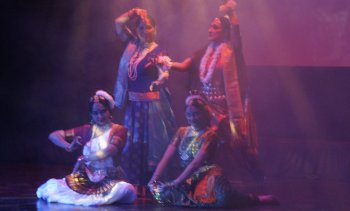 When asked about developing the concept of the production, this is what Ranjana had to say, “I drew inspiration from the Ramayana and wanted to do something on it. Since the Ramayana is celebrated and worshipped in the whole of South East Asia, my intent was to make a point by adding a new dimension to the tale. So I chose these four women characters from the story and wove a tale around their decisions, perspectives, plight and traumas. This is what inspired me to develop the concept. Our scriptwriter Suryakanthi Tripathi is a very enlightened person and she helped us in shaping the four characters.” About the amalgamation of four genres of music and dance, she said, “I chose to do it in four different forms of dance since each of them adds to the music, costume, technique, and ambience. Continuing the tale in one dance form would be monotonous. These characters belonged to different parts of India. Kaikeyi, for example, belonged to Uttar Pradesh, and so you associate her with Kathak. When you think of Surpanakha, you think of South India, and that is why we chose Mohiniattam. Kuchipudi was chosen for Mandodari because they have a Mandodari shabdam in their repertoire. Sita belongs to the Bihar-Orissa region, and so we chose Odissi for her. This choice of dancers was initially intended to be purely artistic and aesthetic, but in the course of things, the choices felt right. The intention was purely to incorporate four different styles of dance. It is not fusion since we don’t overlap with each other. Each of us has our own space, each one adding a new perspective. We have also researched each character extensively, adding a new angle to the story. It was an analytic approach to stir the thoughts of the audience.” The chief guests for the evening were Kumari Selja, minister of social justice and empowerment, and Dr. Suresh Goel of ICCR. Musician and actress Ila Arun was also in the audience. The Ramayana is a story we all have grown up with, and in any time or context, it has a social relevance. It’s not just the story of the journey of Rama, but the journey to Rama. The story has been retold from the perspective of four female characters – women of worth, fire and light - Tejasa. The narrator of the story is also a woman of worth, the mother of Sita, the earth, a witness to the entire story. 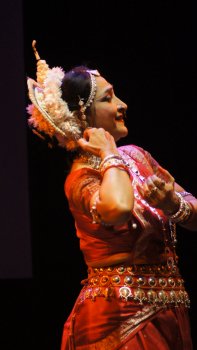 Ranjana Gauhar The narrative begins with the king of Ayodhya, Dasaratha, who has three wives Kaikeyi, Kaushalya and Sumitra. He has four sons, but Rama is the most beloved of them all. Rama and his brother Lakshman are taken by their guru Vishwamitra to Janakpuri, to attend the swayamvar of Sita. Sita was enacted by Ranjana in the Odissi style. The portrayal begins with Sita’s birth from the Mother Earth, ‘Bhoomisuta’ (the daughter of earth). She is the Maithili naresh palita, or brought up by Raja Janak. While playing with her sakhis on a swing, she is described as sakala soundarya sampanna (endowed with all kinds of beauty), nitambita (full-buttocked), vishalalochana (big-eyed). During play in her palaces, Sita lifts the mighty bow of Lord Shiva with one hand and so the king declares that whoever can break the mighty bow, marries Sita. The first meeting between Sita and Rama is described in the chaupais of Manas - ‘Tehi avasar Sita tahan aayi, girijapoojan janani pathai, sanmukh dou raghusinh nihare’ (On that occasion, Sita came to the place where her mother had sent her for girijapoojan, where she admired the two raghuvanshi men in front of her). But her heart is saddened by the oath of her father: ‘Sumiri pita panu, manu ati kshobha’ (since she likes the man she’s seeing, but will have to marry whoever lifts the bow in the swayamvar). All the kings come and leave, unable to move the Shivadhanush. Finally, Rama comes, breaks the bow and Sita puts the varamala on his neck. They now become Sita-Ram. The entire sequence was danced with a lot of dexterity of technique and abhinaya. Ranjana is very graceful, with the tribhangi stance of odissi. Her movements were smooth and footwork and hastas excellent. 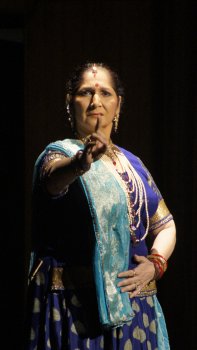 Uma Dogra The narration takes the story further. Sita-Ram are in Ayodhya, and Ram is chosen as the heir to the throne by King Dashratha. Kaikeyi is also happy, but a change of circumstances prompts her to ask for her son Bharat to be crowned the king, and 14 years of exile for Rama. Kaikeyi, portrayed by Uma Dogra in the Kathak style of dance, takes the stage to relate her story. Kaikeyi says that she wants her son to be crowned since the queen or mother should have an equal right to choose the fate of her son. A woman has only one womb, and she should fight for the right of her offspring. Why is it that the father has all the right of decision? Her position is not any different from that of the earth. Kaikeyi then reminisces when many years back, she was fighting a war for the king. She valiantly saves the king, and in return is given two vardaans. She puts off the boons to a future time. On the evening of Rama being announced the heir, Kaikeyi is dressing up to greet her husband, when Manthara walks in. Uma portrayed the expressions of Manthara very well: ‘Lakhau na bhoop kapat chaturai?’ (Can you not see the cunning of the king?) Manthara advises Kaikeyi to ask for her two vardaans. The evil Manthara brainwashes Kaikeyi, who then removes and flings her ornaments, and when the king arrives at her chamber, she’s annoyed: ‘Sumukhi sulochini pikavachini, kaaran mohi sunao’ (My pretty queen, who has beautiful eyes and the voice of a koel, tell me the reason.) Uma further portrays the angry Kaikeyi with flair. ‘Kabahu na lehu na dehu’ (you have never taken, nor given), that’s how she instigates the king. ‘Raghukula reeti sadaa chali aayi, prana jayi par vachana na jaayi’ (It has always been the custom of the Raghukul, the king would rather give up his life than renege on his promise.) Kaikeyi asks for Bharata to be made the king and 14 years of vanavaasa for Rama. Uma enacted Rama, who walks in at this stage – ‘sunahu janani main badabhaagi’ (following my mother’s orders makes me even more fortunate.) Rama asks for permission to leave for the forests – ‘vida maatu sang maangi.’ In a moment of self-realization, Kaikeyi then says that Rama has become her true son. Uma Dogra is an accomplished dancer and her nritya was meticulous. 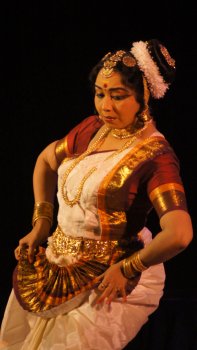 Gopika Varma The narrative then moves on to Rama going to exile. Sita does not want to be left behind, and accompanies her husband to the forest: ‘Viharati vane Sita, sevita bharataa paade’ (Sita is living in the forests, serving at the feet of her husband.) The make their hut in Panchavati, and are happily living together, surrounded by rishis and rishi-patnis. The affection of Rama always leads to self discovery. The next character introduced in the story at this stage was Surpanakha, enacted by Gopika Varma in the Mohiniattam style. Her story begins with the death of her husband. She cries over his dead body and remembers his hands that she had held in marriage, his feet, the body that she had rested on as a soft bed, his forehead with the tilak, his eyes and face that she had beheld. She goes mourning to her brother Ravana, who had killed her husband. He promises her remarriage to the person of her choice. That’s how she became a demoness in her sorrow. When she sees Rama, ‘apurva tejasvi purush’ in the forest, she requests him to accept her as his wife. Rama refuses, saying that he is already married and sends her to Lakshman. She is spurned by both, and Lakshman chops off her nose. Surpanakha goes back to Ravana, and tells him, ‘main Ravana ki bhagini hoon, mera aisa haal hai toh sriyatva ka kya hoga’ (I am the sister of Ravana. If this is my state, what will become of the rest of womanhood?) Gopika’s portrayal of the demoness was excellent and her mukhabhinaya in particular was flawless. The music and percussion were very good. 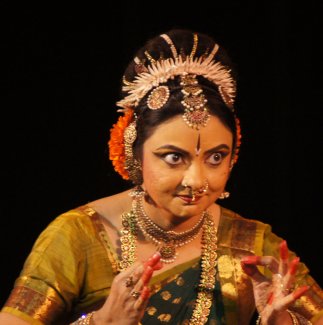 Deepika Reddy The focus again shifts to Sita. Ranjana as Sita is sitting and threading flowers when Ravana comes asking for alms. He kidnaps Sita, who is taken away forcibly. He has abducted Sita as his prize. Sita then asks, why does a woman get her boundary marked by a man, and gets captured by another man on violating it? Only mother earth can escape this fate. It was a touching tale. The narrator then tells the story of Hanuman on a quest to locate Sita. Finally, Rama arrives in Lanka and battles follow. The mighty Ravana falls dead and his wife Mandodari is left to lament. Thus Mandodari’s character is introduced, enacted by Deepika Reddy in Kuchipudi. ‘Main Mandodari’ is her narcissistic chant. ‘Main sundar, saral, navkomal, advitiya’ (I am beautiful, simple, delicate, unparalleled.) Her birth is from a statue, ‘cheer kar murat nikli ik naar.’ She keeps ranting about the fact that she was the dearest wife of Ravana: ‘Main priyamani Ravana ki rani.’ She is the queen and the proud mother of three brave sons – Indrajeet, Atikaya and Akshaya Kumar. But Ravana is an unfaithful, lecherous husband. When Rama comes looking for Sita, he looked at Mandodari once, which was enough to win her shraddha. Ravana hurt her pride when he told her that if Sita becomes his queen, Mandodari would be her sevika. A hurt Mandodari then compares her chastity and purity to Sita’s. ‘Dharam nibhaye maine nishtha se, nibh na saka ae swami ekmatra dharam bhi nishtha se’ (I have fulfilled all my duties my husband, you could not fulfill even one.) Then, she is shattered by the news of his death. She laments becoming patiheen, putraheen, pativrataheen, narak ki bhaagi (deprived of a husband, sons, the fortune of wifehood, the partaker of hell). ‘Kisne bhagya likha mera, kiya na kuch bhi paap maine, prayaschit karoon main kya’ (Who wrote this fate for me? I have not sinned, what atonement can I do?) Do I still call myself Mandodari? Every war brings unrelenting sorrow. Deepika’s excellent act with some remarkable abhinaya made it clearly my favourite. The next act made some thought-provoking statements. Sita was subjected to agnipariksha before she was brought back from Lanka. So she makes a statement that she was married to Rama keeping the agni saakshi, so why should she be made to take an agnipariksha to prove her satitva? She repeatedly says that she is Sita and not Sati, and asks her mother, the earth, to embrace her and take her in her arms. Ranjana’s abhinaya as Sita touched the audience. At the end, Urdu poetess Nikhat Nehdi recited a few lines on Sita – ‘Sita ko dekhega saara gaon, agni par rakhegi paon, bach jayegi toh banegi sati, jal jaye toh papin.’ Finally, this was how the tale of these four women ended. They are not merely women, but earth’s own daughters or blossoms, who contain the light within them – Tejasa. Shveta Arora is a blogger based in Delhi. She writes about cultural events in the capital. |